by Voxeu.org
— this post authored by Sandra Black, Jason Furman, Laura Giuliano, and Wilson Powell
Over the past three years, 18 states plus the District of Columbia have implemented minimum wage increases, joining ten other states that have raised their minimum wages at least once since the last Federal increase in 2009. This column examines the impact of the more recent state increases on wages, weekly earnings, and employment among workers in the low-wage leisure and hospitality Industry. A comparison with states with no minimum wage increase since 2009 suggests that the recent legislation contributed to substantial wage increases with no discernible impact on employment levels or hours worked.

Real wage growth has picked up in the US in the last several years. Since the end of 2012, real average hourly earnings for production and non-supervisory workers have grown at a 1.4% annual rate, well above the 0.1% annual growth rate from 1980 to 2007. A broad range of households have seen their incomes rise, with stronger income growth for households in the middle of the income distribution and especially strong growth at the bottom of the distribution (Figure 1). In 2015 real income of households at the 10th percentile of the income distribution grew 7.9% – the fastest growth since 1968.
Figure 1 Growth in real household income by percentile, 2014-2015
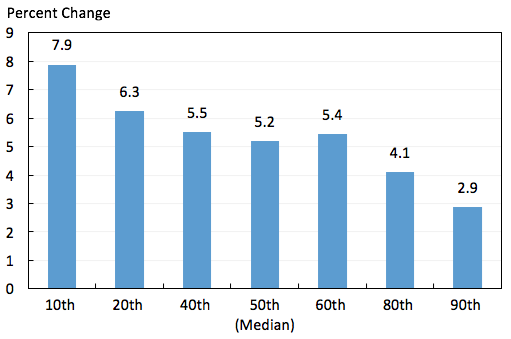
Source: Census Bureau; CEA calculations.
The pickup in wage and income growth has a number of causes, including continued strengthening in the economy, tighter labour markets, and the fall in the price of gasoline. A new analysis by President Obama’s Council of Economic Advisers (CEA) finds that minimum wage increases implemented over the past three years by 18 states and the District of Columbia have also contributed to substantial increases in average wages for workers in low-wage jobs, helping to reverse a pattern of stagnant or falling real wages in the preceding years. Moreover, this has occurred without any sign of an impact on employment or hours worked. As a result, average wages and weekly earnings for those who work in the lowest paid jobs are at least 6.6% higher in these states than they would have been in the absence of these policy changes, based on a conservative counterfactual.
As the real value of the Federal minimum has declined, many states have raised their minimum wages
The US Federal minimum wage has been unchanged at $7.25 per hour since 2009. Adjusted for inflation, the current value is nearly a quarter below its historical peak in 1968 and roughly 10% below its 2009 level (Figure 2).
Figure 2 Real value of the Federal minimum wage, 1960-2015
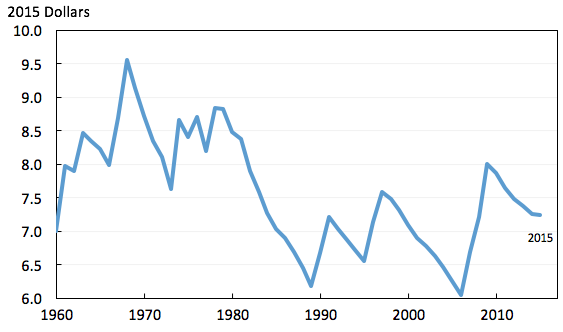
Source: Census Bureau; CEA calculations.
In February 2013, President Obama proposed to raise the Federal minimum wage. While Congress failed to act, many states and localities have raised their own minimum wages (which can exceed the Federal minimum wage but not, for most workers, fall below it). Between January 2014 and October 2016, 18 states plus the District of Columbia implemented increases – in several cases, raising the state minimum above a rate that was already higher than the Federal minimum. As a result, the average minimum wage in these states, weighted by the number of private sector workers in each state, rose from $7.66 in December 2013 to $9.34 in October 2016 – an increase of 22% (Figure 3).
In enacting new minimum wage legislation, these 18 states and the District of Columbia joined a broader group of states that have raised their minimum wages at least once since the last Federal minimum wage increase in 2009. Because several states among this broader group index their minimums to inflation to prevent erosion of the real value over time, the average minimum wage has continued to grow since 2013 – albeit at a relatively slow pace – even in states that have not implemented new minimums since 2013.[1]
In contrast, in 22 states, the minimum wage has not risen at all in the years since the last Federal increase. And of this group, only one state has a wage floor that is above the Federal minimum of $7.25.
Figure 3 Average minimum wage
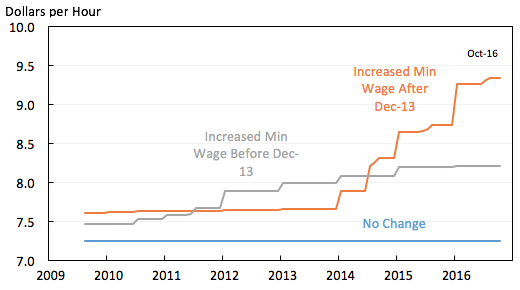
Notes: State minimum wages are weighted using average total private sector employment in each state from August 2009 through December 2013.
Source: Census Bureau, Current Employment Statistics; CEA calculations.
The increasing divergence in minimum wage policy across states offers a way to assess the impact that a higher state minimum has on wages, earnings, hours, and employment of low-wage workers. In particular, the trends in states that did not raise their minimums may provide a useful gauge for what would have happened in the states that raised their minimums had they failed to enact these policies.
State legislation’s impact on wages: Dramatic growth and reversal of prior downward trend
To assess the impact of minimum wage increases enacted by States in recent years, CEA analysed data from the Bureau of Labor Statistics for workers in the leisure and hospitality industry – a group who tend to earn lower wages than those in other major industry groups and thus are most likely to be affected by minimum wage policy. As of December 2013, the typical leisure and hospitality worker earned $9.25 per hour – roughly the 17th percentile of the national wage distribution – and nearly half of these workers earned an hourly wage less than 120% of the minimum wage in their state.
Figure 4 compares wage trends in leisure and hospitality in the states that raised their wage floors in January 2014 or later to those that had no increase since the last Federal minimum wage increase in 2009. The figure shows a slight downward trend prior to 2014 in the states that ultimately raised their minimum wages, while wages were growing, albeit at a slow pace, in the other group of states.
This pattern changed dramatically in 2014 as the former group of states began implementing their minimum wage increases. Though 2014 saw the beginning of a nationwide acceleration in wage growth, wages rose significantly faster in leisure and hospitality for workers in states that raised their minimum wages compared to those that did not. Specifically, CEA estimates that in states that took action, the average industry wage grew by 14.2% between December 2013 and October 2016 – resulting in wages that were 14.8% higher than they would have been had the downward trend prior to January 2014 continued. By comparison, the average wage in the comparison group of states grew by 7.2% and was only 4.5% higher by October 2016 than the counterfactual based on the prior trend.
What do these comparisons tell us? First, the nationwide acceleration of wage growth since 2014 – even in states where the minimum wage was flat – suggests that even if the states that raised their minimums had not done so, wages would have reversed course and begun to grow. Hence some of the progress as measured by the 14.8% increase above the previous trend is likely due to factors that helped spur the acceleration in wage growth across the country. Importantly, however, the difference in wage growth between the two groups of states suggests that the minimum wage increases likely contributed to a significant portion of that gain. Even if we use an optimistic counterfactual – and assume that wages in the minimum wage states would have grown at a pace of 7.2% as they did in comparison states (despite slower growth in the former group leading up to that point) – we conclude that the state legislation led to roughly a 6.6% rise in the average industry wage in those states that raised their minimum wages.
Figure 4 Average hourly earnings, leisure and hospitality
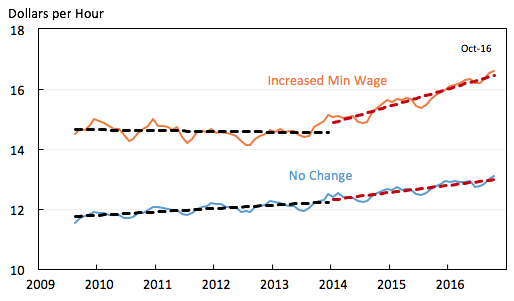
Note: Dashed lines indicate linear trend.
Source: Census Bureau, Current Employment Statistics; CEA calculations.
Trends in weekly earnings parallel the trends in hourly wages
Figure 5a shows the evolution of average weekly earnings in the two groups of states over the same time period. These trends closely resemble the trends seen in average wages. In the states that raised their minimum wages, average weekly earnings of leisure and hospitality workers saw a slight jump in January 2014 followed by a steady upward trend – a dramatic reversal of the slight negative trend over the previous four and a half years. By October 2016, weekly earnings in these states were a full 16.4% higher than they would have been had they stayed on their prior course. Meanwhile, workers in the states that had no minimum wage changes saw modestly faster weekly earnings growth beginning in 2014, resulting in an increase of 4.7% by October 2016.
The conclusion that the minimum wage increases had a similar impact on weekly earnings as they did on hourly wages implies that the higher wages did not come at the expense of reduced hours – which might have reduced the overall benefit for low-wage workers.
Figure 5b compares weekly earnings trends in the two groups of states for the private sector overall, and provides further evidence that the divergence of trends among leisure and hospitality workers (seen in Figure 5a) was driven mainly by the minimum wage increases. Among all private sector workers – most of whom have notably higher earnings than the minimum wage level and thus could not plausibly have been affected by the increase – there was no significant difference in the growth rate of average weekly earnings between the two groups of states. This is what we would expect to see if overall economic conditions were similar in the two groups of states. It thus supports the conclusion that the acceleration in earnings growth among leisure and hospitality workers in the states without minimum wage increase provides a plausible counterfactual for the changes that would otherwise have occurred in States that raised their minimums.
Figure 5a Average weekly earnings, leisure and hospitality
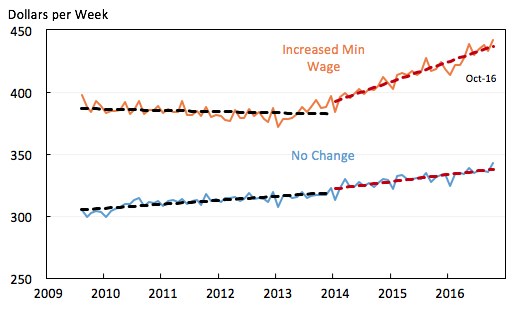
Note: Dashed lines indicate linear trend.
Source: Census Bureau, Current Employment Statistics; CEA calculations.
Figure 5b Average weekly earnings, total private
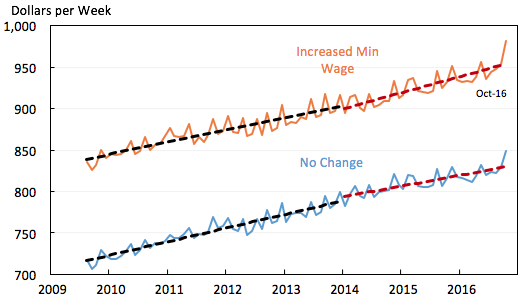
Note: Dashed lines indicate linear trend.
Source: Census Bureau, Current Employment Statistics; CEA calculations.
While this conclusion means that state legislation increases earnings for workers in states that raise their minimums, it also means that workers in other states are left even further behind by the stagnant Federal minimum wage. An increasing divergence in state policy and a continued failure of Congress to raise the Federal minimum wage could thus exacerbate the well-documented dispersion of incomes that has been growing even among workers in the same industries (Barth et al. 2016, Song et al. 2015).
No evidence that higher wages have impacted employment levels
The evidence illustrated in Figure 5a suggests that recent state minimum wage increases have led to higher wages without affecting hours worked. But some argue that even if a higher minimum wage does not cause employers to cut back on hours of low-wage workers, it might lead to reductions in employment, an often-voiced concern among critics of recent state minimum wage legislation. The analysis illustrated in Figure 6, however, shows that employment in the leisure and hospitality industry follows virtually identical trends in states that did and did not raise their minimum wage. Moreover, employment in this low-wage industry grew somewhat more quickly than employment in the private sector overall.
Figure 6 Total employment
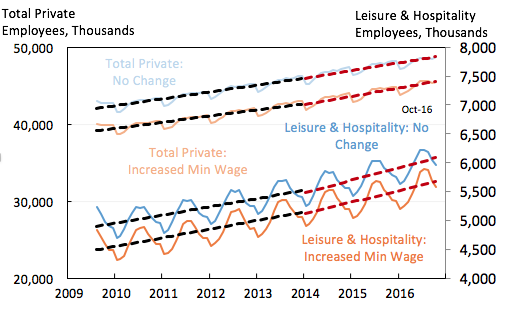
Note: Dashed lines indicate linear trend.
Source: Census Bureau, Current Employment Statistics; CEA calculations.
This finding is consistent with a well-established empirical literature in which minimum wage increases are often found to have no discernible impact on employment (Card and Krueger 2016, Belman and Wolfson 2014). And moreover, it is also supported by economic theory. In fact, when employers have sufficient market power – so-called monopsony or wage-setting power in the labour market – and can set wages below what would prevail in a perfectly competitive market, there is scope for a higher minimum wage to raise both wages and employment.
Economists and policymakers are increasingly recognising that employers often have some degree of monopsony power in labour markets. And a recent CEA report discusses some reasons to think that such wage-setting power may be on the rise – including a long-run decline in labour mobility and a similar decline labour’s share of national income. To the extent this is true, it makes the case for a higher Federal minimum wage all the more compelling.
Raising the wages and incomes of working Americans is one of the country’s greatest policy challenges, and it has been a central goal of many of the Obama Administration’s initiatives and proposals. The analysis presented here, along with a larger body of economic research, provides further support for the view that moderate minimum wage increases can substantially boost earnings for low-wage workers with little or no impact on employment.
References
- Barth, E, A Bryson, J C. Davis, and R Freeman (2016), “It’s Where You Work: Increases in Earnings Dispersion across Establishments and Individuals in the U.S.” Journal of Labor Economics 34(S2).
- Belman, D and P J Wolfson (2014), What Does the Minimum Wage Do? W.E. Upjohn Institute for Employment Research: Kalamazoo, MI.
- Card, D E and A B Krueger (2016), Myth and measurement: The New Economics of the Minimum Wage, Twentieth Anniversary Edition. Princeton, NJ: Princeton University Press.
- Council of Economic Advisers (2016). “Labor Market Monopsony: Trends, Consequences, and Policy Responses.”
- Song, J, D J Price, F Guvenen, N Bloom and T von Wachter (2015) “Firming Up Inequality.” NBER Working Paper No. 21199.
Endnotes
[1] The broader group of states that have passed legislation since 2009 also includes four states that recently approved ballot measures to raise their minimum wages in the future. In addition, more than 60 cities and counties have passed increases to their local minimum wages.
About The Authors
 Sandra Black is a member of the Council of Economic Advisers. She is on leave from the University of Texas, Austin where she holds the Audre and Bernard Rapoport Centennial Chair in Economics and Public Affairs and is a Professor of Economics. Dr. Black has worked as an Economist at the Federal Reserve Bank of New York, and as an Assistant, Associate, and ultimately Professor in the Department of Economics at UCLA before arriving at the University of Texas, Austin in 2010.
Sandra Black is a member of the Council of Economic Advisers. She is on leave from the University of Texas, Austin where she holds the Audre and Bernard Rapoport Centennial Chair in Economics and Public Affairs and is a Professor of Economics. Dr. Black has worked as an Economist at the Federal Reserve Bank of New York, and as an Assistant, Associate, and ultimately Professor in the Department of Economics at UCLA before arriving at the University of Texas, Austin in 2010.
She was previously the Editor of the Journal of Human Resources, a Research Associate at the National Bureau of Economic Research, and a Research Affiliate at the Institute for the Study of Labour. Dr. Black’s research focuses on the role of early life experiences on the long-run outcomes of children, as well as issues of gender and discrimination. She received her B.A. from the University of California, Berkeley and her Ph.D. in economics from Harvard University.
 Jason Furman is the Chairman of the Council of Economic Advisers. He was confirmed by the U.S. Senate on August 1, 2013. Prior to this role, Furman served as Assistant to the President for Economic Policy and the Principal Deputy Director of the National Economic Council. From 2007 to 2008 Furman was a Senior Fellow in Economic Studies and Director of the Hamilton Project at the Brookings Institute. Previously, he served as a Staff Economist at the Council of Economic Advisers, a Special Assistant to the President for Economic Policy at the National Economic Council under President Clinton and Senior Adviser to the Chief Economist and Senior Vice President of the World Bank. Furman was the Economic Policy Director for Obama for America.
Jason Furman is the Chairman of the Council of Economic Advisers. He was confirmed by the U.S. Senate on August 1, 2013. Prior to this role, Furman served as Assistant to the President for Economic Policy and the Principal Deputy Director of the National Economic Council. From 2007 to 2008 Furman was a Senior Fellow in Economic Studies and Director of the Hamilton Project at the Brookings Institute. Previously, he served as a Staff Economist at the Council of Economic Advisers, a Special Assistant to the President for Economic Policy at the National Economic Council under President Clinton and Senior Adviser to the Chief Economist and Senior Vice President of the World Bank. Furman was the Economic Policy Director for Obama for America.
Furman, who earned his Ph.D. in economics and a M.A. in government from Harvard University and a M.Sc. in economics from the London School of Economics, has also served as Visiting Scholar at NYU’s Wagner Graduate School of Public Service, a Visiting Lecturer at Yale and Columbia Universities, and a Senior Fellow at the Center on Budget and Policy Priorities. He has conducted research in a wide range of areas, including fiscal policy, tax policy, health economics, Social Security, and monetary policy. In addition to numerous articles in scholarly journals and periodicals, Furman is the editor of several books on economic policy, including Path to Prosperity and Who Has the Cure.
 Laura Giuliano is Senior Economist, Council of Economic Advisers; and Associate Professor of Economics, University of Miami. Giuliano specializes in labor and education. She received a BA from the University of Virginia, and MA in International Relations from Yale University, and a Ph.D. in Economics from the University of California, Berkeley. She is on leave from the University of Miami.
Laura Giuliano is Senior Economist, Council of Economic Advisers; and Associate Professor of Economics, University of Miami. Giuliano specializes in labor and education. She received a BA from the University of Virginia, and MA in International Relations from Yale University, and a Ph.D. in Economics from the University of California, Berkeley. She is on leave from the University of Miami.
 Wilson Powell III is a Research Economist at the Council of Economic Advisers where he focuses on labor and health policy. He graduated summa cum laude from Dartmouth College. Prior to joining the Council of Economic Advisers, he worked as a Health Policy Fellow at The Dartmouth Institute for Health Policy and Clinical Practice.
Wilson Powell III is a Research Economist at the Council of Economic Advisers where he focuses on labor and health policy. He graduated summa cum laude from Dartmouth College. Prior to joining the Council of Economic Advisers, he worked as a Health Policy Fellow at The Dartmouth Institute for Health Policy and Clinical Practice.







